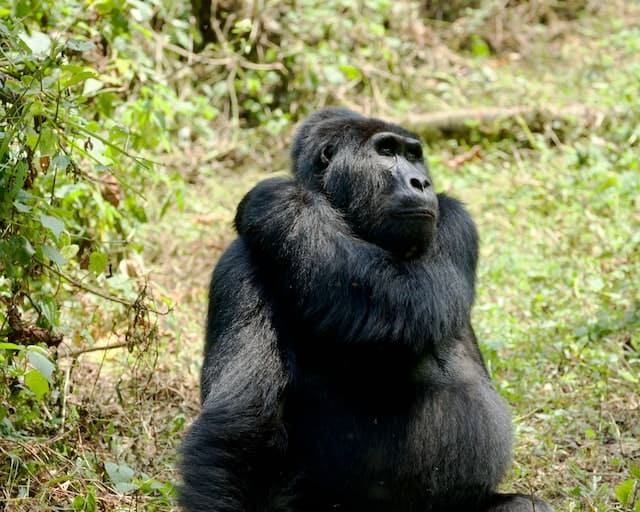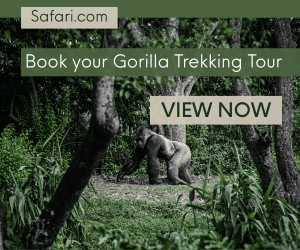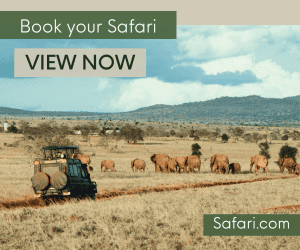Table of Contents
- So – is gorilla trekking safe?
- Things to consider before gorilla trekking: 4 Safety Tips
- Recap: Is gorilla trekking safe in Africa?
Is gorilla trekking safe? Yes! Read on to set your mind at ease!
Gorilla trekking in East Africa is arguably the best wildlife experience on the planet. Spending an hour with these magnificent creatures is something that is on so many people’s bucket lists, and it’s one of those once-in-a-lifetime experiences that certainly doesn’t disappoint!
But given that some people perceive countries in East Africa to be somewhat unstable – is gorilla trekking safe?
I’ve been on a gorilla trek myself, and I live less than an hour away from Bwindi Impenetrable forest, Uganda’s premier gorilla trekking destination. So, in this article, I explain, from my experience, why gorilla trekking in East Africa is perfectly safe and why you shouldn’t hesitate when it comes to booking this incredible experience!
So – is gorilla trekking safe?
Yes, gorilla trekking in East Africa is completely safe. You are guided into the national park by armed rangers, who remain by your side at all times and during your experience with the gorillas. They then lead you back out of the park and to the park entrance, where your driver will be waiting to take you back to your hotel.
Ultimately, gorilla trekking is extremely safe and well-organized, both in Uganda and Rwanda. That being said, I offer some important safety tips to consider before undertaking gorilla trekking in what remains of this article.
Things to consider before gorilla trekking: 4 Safety Tips
Some people are slightly anxious about visiting East Africa for the first time, as the region has a history of instability. However, at the time of writing, both Uganda and Rwanda are peaceful and generally very safe for tourists. DR Congo, on the other hand, is a different issue and should be avoided. Provided that you arrange your safari trip through a certified and trusted safari company, you don’t need to worry about your general safety throughout your trip.
So, with that in mind, here are some things to think about to make sure that your upcoming gorilla trek is as safe as possible:
Book your trek with a trusted safari company
As is the case with any tourism activity, make sure you book your gorilla trek with a trusted safari company to ensure that they take care of your safety and security. The vast majority of Ugandans & Rwandans are courteous and friendly toward tourists, but arranging your trip with a trusted tour company adds an element of security to your trip.
I highly recommend Andrew and the team at AJ Tours & Travel, specialists in gorilla trekking, safaris, and other activities in East Africa. You can reach out to the team to ask them to arrange your gorilla trek in either Uganda or Rwanda.
Listen to the rangers
When you arrive at the national park in preparation for your gorilla trek, you will be greeted by armed rangers who are tasked with protecting you – and the animals – as they take you on your trek through the forest.
The rangers are highly trained and friendly and are there to ensure that you have a memorable experience for all the right reasons. Before your trek begins, the rangers run you through a safety briefing, which explains how close you can get to the gorillas and what you need to look out for during your trek.
Provided that you listen to the rangers and follow their guidance and advice, your gorilla trek will be completely safe. The rangers will be by your side for the entirety of your trek, and they are there to protect you – so you can rest assured that the entire trek is safe from start to finish.
Be respectful to wild animals

When you enter a national park, you’re entering the home of wild animals. Of course, wild animals are unpredictable, which is why you need to show them respect. The gorillas that you trek in Uganda and Rwanda are habituated, meaning they’re used to humans and don’t typically show aggression.
However, if you overstep the mark and get too close, you risk provoking the gorillas, which is a bad idea! Naturally, the rangers will explain how close you can get to the animals and will warn you if you encroach on their space during your trek.
But make sure you enter the forest in the mindset that you’re entering the natural territory of wild animals, and you need to show them respect! This will help you to avoid any unforeseen circumstances during your encounters.
Wear appropriate footwear
One of the biggest threats to your safety when entering a national park in East Africa is the terrain, not the animals that you’re likely to encounter. Whether you’re trekking in Uganda or Rwanda, things are likely to be wet underfoot, and as you’re walking through the bush, you can easily lose your footing if you’re not wearing the correct footwear.
So, be sure to wear a pair of sturdy walking boots for your gorilla trek and ensure that you follow the path laid out by the rangers. Walking through the African bush can be exhilarating, but if you’re not careful where you put your feet, it can also lead to injury!
Recap: Is gorilla trekking safe in Africa?
The bottom line is yes, gorilla trekking in Africa is safe. However, to make sure your experience is memorable for all the right reasons, be sure to bear the following safety tips in mind:
- Book your experience with a reputable tour company.
- Listen to the rangers and follow their instructions at all times!
- Be respectful to the wild animals that you encounter.
- Wear appropriate footwear.
Provided that you book with a reputable company, the moment that you arrive at the entrance to the national park in Uganda or Rwanda, the rangers take care of everything for you. They guide you into the park and are present for the entire time that you’re with the gorillas. They then lead you out of the park and back to your awaiting safari vehicle.
So, provided that you’re sensible, gorilla trekking in East Africa is a perfectly safe activity.
Keen to discover your options for this once-in-a-lifetime tourism opportunity? Discover where to go gorilla trekking in East Africa in this comprehensive guide!




